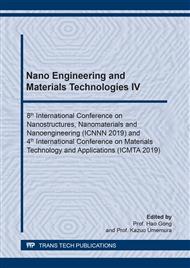p.267
p.272
p.277
p.283
p.291
p.296
p.302
p.306
p.312
Experimental Investigation the Effect of Cleaning on the Optical and Mechanical Properties of PV Module Glasses
Abstract:
Poor transmission of sunlight through the top glass cover is one of the major hindrances in realizing better performance from a PV module. Adoption of appropriate cleaning technique might enhance glass transmissivity to a good extent. In the present study, the effect of manual cleaning with nylon sponge, microfiber cloth and nylon brush on optical and mechanical properties of PV glass have been investigated for several samples of borosilicate and soda lime glasses. Examination of transmittance of the samples using UV-VIS NIR scanning spectrophotometer confirmed enhanced transmissivity. Borosilicate glass exhibited better performance in terms of transmissivity as compared to soda lime glass. Cleaning with nylon sponge shows the highest transmittance of 91.98% for borosilicate glass at 630 nm wavelength and that of 91.094% with soda lime at 525 nm wavelength.
Info:
Periodical:
Pages:
291-295
Citation:
Online since:
May 2020
Authors:
Keywords:
Price:
Сopyright:
© 2020 Trans Tech Publications Ltd. All Rights Reserved
Share:
Citation:


